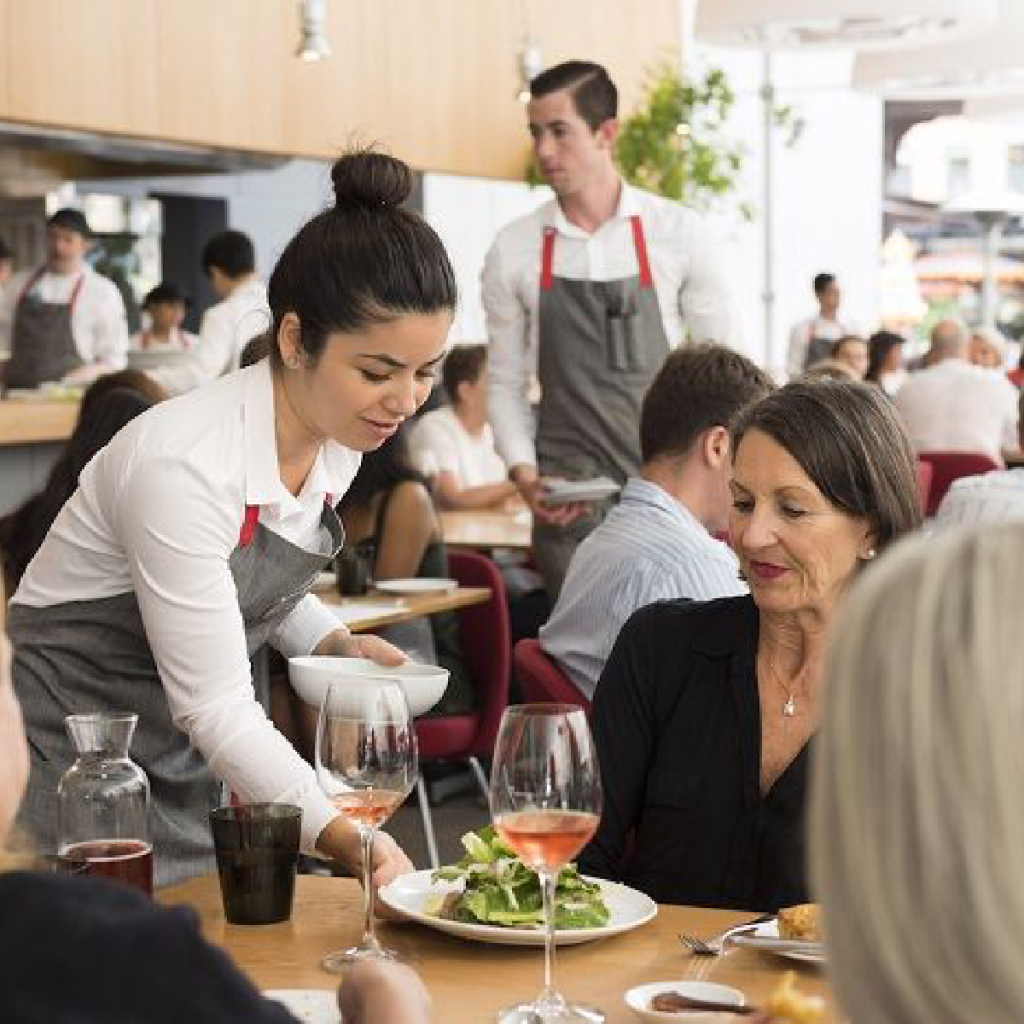Learn effective strategies to manage impulsiveness in a restaurant setting.
How to Handle Impulsiveness in a Restaurant
Are you the kind of person who always orders more than you can eat at a restaurant? Can’t resist that dessert menu? Or maybe you find yourself changing your mind about your order five times before the waitress can even grab a pen? Well, my friend, you are not alone! In this article, we’re going to dive into the world of impulsiveness in restaurants and explore the best strategies for managing those impulsive urges. So, grab a chair (but don’t order anything just yet) and let’s get started!

Understanding Impulsiveness
Before we start tackling the issue head-on, it’s essential to understand what we mean by impulsiveness. Impulsiveness can be defined as the tendency to act without thinking or considering the consequences. It’s that little voice in your head that makes you say, “I’ll have one more cocktail, please!” even though you know you’ve had enough. We all have that impulsive streak from time to time, but let’s dig deeper into the psychology behind it.
Defining Impulsiveness
To truly comprehend impulsiveness, we need to break it down. Think of it as a spectrum, with impulsive behavior ranging from mild to extreme. Some people may only exhibit occasional impulsiveness, while others struggle with a constant battle to resist temptation. Perhaps you’re the type who can’t resist ordering that extra appetizer. Or maybe you’re the adventurous soul who always goes for the “Chef’s Special,” no matter what it is. Wherever you fall on the spectrum, remember, it’s all about finding the right balance.
The Psychology Behind Impulsiveness
So, what pushes us to act impulsively in a restaurant setting? Well, there are a few factors at play. First, there’s the thrill of the moment. Restaurants create an exciting atmosphere that can awaken our impulsive side. The sight and aroma of delicious food, the lively chatter of other diners – it’s like an impulsive playground for our senses! Add in the element of socialization, and it’s no wonder that we sometimes let our impulses guide our decisions.
But there’s more to it than just the ambiance. Impulsiveness can also be linked to personality traits. Some individuals are naturally more impulsive than others due to factors such as genetics or environmental influences. So, if resisting that slice of triple chocolate cake feels like an uphill battle every time, cut yourself some slack! It’s not entirely your fault. Blame it on your genes or that enticing cake.
Furthermore, impulsiveness can also be influenced by our emotional state. When we’re feeling stressed or overwhelmed, our ability to think rationally and make thoughtful decisions may be compromised. In these moments, our impulsive tendencies can take over, leading us to act on immediate desires without considering the long-term consequences. It’s like a temporary escape from the pressures of life, even if it’s just for a few bites of that mouthwatering dessert.
Additionally, societal and cultural factors can play a role in shaping our impulsiveness. In a world that values instant gratification and encourages impulsive behaviors through advertisements and social media, it’s no wonder that we find it challenging to resist temptation. The constant exposure to enticing images and messages can weaken our self-control and make it harder to resist impulsive urges.
Moreover, our past experiences and learned behaviors can contribute to our impulsiveness. If we’ve been rewarded for impulsive actions in the past, our brain may associate impulsive behavior with positive outcomes. For example, if we’ve received praise or attention for indulging in a spontaneous purchase, our brain may be more inclined to repeat that behavior in the future. These learned associations can create a cycle of impulsiveness that is challenging to break.
It’s important to note that impulsiveness is not inherently negative. In certain situations, acting on impulse can lead to exciting and spontaneous experiences. However, when impulsiveness becomes a pattern that negatively impacts our lives, it’s essential to develop strategies to manage and regulate our impulsive tendencies.
So, the next time you find yourself faced with an impulsive decision at a restaurant or in any other aspect of life, take a moment to reflect on the underlying factors at play. Consider the thrill of the moment, the influence of personality traits, the impact of emotions, the role of societal and cultural factors, and the power of past experiences. By understanding the psychology behind impulsiveness, we can gain insight into our own behaviors and work towards finding a healthier balance.
The Impact of Impulsiveness in a Restaurant Setting
Now that we’ve explored the ins and outs of impulsiveness, let’s dive deeper into its impact in the restaurant world. Impulsive behavior can have significant effects on both customers and staff, so it’s crucial to understand how it plays a role in various aspects of the dining experience.
When it comes to customer satisfaction, impulsiveness can be a double-edged sword. Think about the last time you dined out and had an impulse ordering spree. Did it result in complete satisfaction, or did you end up with a case of buyer’s remorse? Impulsive decisions can lead to surprising and delightful culinary adventures, but they can also leave you feeling unsatisfied, with a plate full of regrets.
Restaurants must strike a delicate balance between catering to customers’ whims and ensuring a fulfilling experience. By understanding the psychology behind impulsiveness, they can better guide their patrons towards choices that align with their desires and taste preferences. This could involve offering a diverse menu with a range of options to satisfy impulsive cravings while also providing recommendations based on popular dishes or personal preferences.
However, impulsiveness not only affects customers but also has a significant impact on the efficiency of restaurant staff. Imagine being a harried server, trying to juggle multiple tables while dealing with a customer who continuously changes their order. It’s a nightmare! Impulsive behavior can slow down the entire service process, causing delays and frustration for both customers and staff.
To mitigate the negative effects of impulsiveness on staff efficiency, restaurants should aim to manage impulsive behavior effectively. Implementing strategies that streamline the ordering process and minimize disruptions can make a significant difference. For example, encouraging customers to take a moment to decide their order before summoning the server can help alleviate stress for everyone involved. Additionally, providing clear and concise menus with detailed descriptions can help customers make more informed decisions, reducing the likelihood of impulsive changes to their orders.
Furthermore, training staff to handle impulsive customers with patience and understanding can contribute to a smoother dining experience. By equipping servers with effective communication skills and the ability to offer alternative options or suggestions, they can navigate impulsive situations more efficiently and ensure customer satisfaction.
In conclusion, impulsiveness plays a significant role in the restaurant setting, impacting both customers and staff. By understanding the dynamics of impulsiveness and implementing appropriate strategies, restaurants can create an environment that caters to impulsive desires while maintaining efficiency and customer satisfaction. So, the next time you dine out, take a moment to reflect on the impact of impulsiveness and how it shapes your dining experience.
Strategies to Manage Impulsive Behavior
Now that we’ve examined the impact of impulsiveness in a restaurant setting, let’s dive into some practical strategies to help manage those impulsive urges. Remember, self-control is key, but a little guidance goes a long way!
Techniques for Self-Control
When temptation strikes, it can feel nearly impossible to resist. But fear not, for there are techniques you can employ to regain control. One effective strategy is to practice mindfulness. Take a moment to pause and check in with yourself. Are you truly hungry, or is it just your impulsive side trying to take the wheel?
Additionally, setting clear goals and intentions before heading out for a meal can help you stay on track. Decide what you want to eat and stick to it. You’ll feel empowered and satisfied, knowing you made a conscious choice rather than succumbing to impulsive whims.
Mindfulness and Impulsiveness
Mindfulness isn’t just for yoga retreats and meditation sessions; it can also be a powerful tool in managing impulsive behavior. By practicing mindfulness, we become more aware of our thoughts and feelings in the present moment. This heightened self-awareness can help us recognize when we’re acting impulsively and give us the chance to make a more deliberate choice.
You can start by paying attention to your surroundings while dining out. Notice the flavors, textures, and smells of each bite. Engage in meaningful conversations with your dining companions. By being fully present and mindful, you can enjoy the dining experience in a more balanced way, free from impulsive decisions.
Implementing Policies to Curb Impulsiveness
Individual strategies for managing impulsiveness are essential, but it’s equally important for restaurants to implement policies that discourage impulsive behavior. After all, prevention is better than cure!
Training Staff to Handle Impulsive Customers
Restaurant staff are on the front lines when it comes to managing impulsive behavior. Providing them with proper training and guidance is crucial for creating an environment that promotes balanced decision-making. Staff should be equipped with the tools to handle impulsive customers effectively and help guide them towards choices that align with their desires.
Furthermore, staff training should focus on active listening and empathy. By understanding the underlying motivations behind impulsive behavior, staff can approach customers with genuine care and provide tailored recommendations that meet their needs. Empathy is a powerful tool in managing impulsiveness, as it helps create a bond of understanding between staff and customers.
Creating an Environment that Discourages Impulsiveness
In addition to staff training, restaurants can take proactive steps to create an environment that discourages impulsive behavior. For example, altering the menu layout to emphasize healthier options can steer customers towards more mindful choices. Providing clear and informative descriptions can also help customers make informed decisions rather than impulsive ones.
Restaurants can also consider implementing innovative ordering systems that encourage customers to think before they order. For instance, offering a “pause and reflect” button on digital menus can give customers a moment to consider their options before hitting the order button. Small changes like these go a long way in managing impulsiveness.
The Role of Communication in Managing Impulsiveness

Effective Communication with Impulsive Customers
It’s essential for staff to communicate clearly with impulsive customers to ensure that their needs are met. By actively listening and acknowledging their desires, staff can guide them towards choices that satisfy their cravings while still aligning with their goals. Creating a non-judgmental and supportive environment enables customers to feel heard and understood, reducing the likelihood of impulsivity.
Communication Among Staff Members
Cohesive communication among staff members is equally important. By sharing insights and observations about impulsive customer behavior, staff can learn from each other and develop strategies to handle impulsive situations more effectively. Setting up regular team meetings and encouraging open dialogue can foster a sense of camaraderie that empowers staff to tackle impulsive challenges as a unified force.
So, there you have it – a comprehensive guide to handling impulsiveness in a restaurant. From understanding the psychology behind it to implementing effective strategies, managing impulsiveness is an ongoing journey. By empowering both customers and staff with knowledge and tools, we can create dining experiences that are balanced, satisfying, and, most importantly, reflective of our conscious choices. So go out there, indulge mindfully, and savor each bite without those impulsive regrets!



